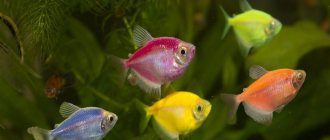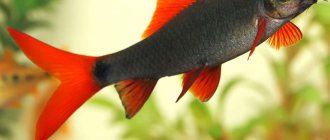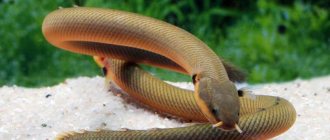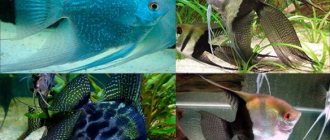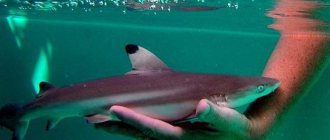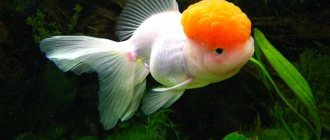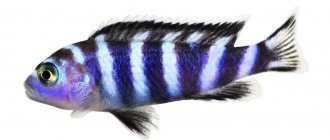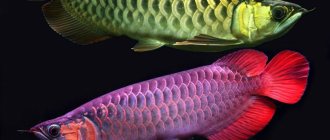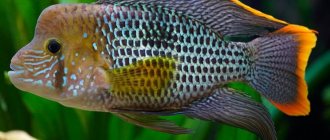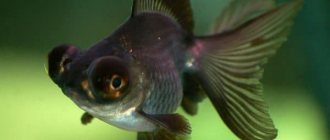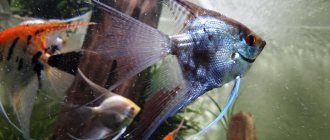Aquarium fish angelfish photo and description
Angelfish are the most common aquarium fish of the cichlid family, which are not only very beautiful, but also have unusual behavior that distinguishes them from others. There are three types of angelfish:
- The common angelfish has a classic body shape of a silvery color with four transverse stripes;
- Angelfish altum or tall-bodied, characterized by an elongated body - some grow up to 30 cm in height;
- Leopold's angelfish is a small species with an aggressive disposition.
- golden green, smoky, striped, black,
- two-color (bicolor);
- tricolor (Koi).
- lace;
- zebra;
- train or veil;
- black;
- gold;
- blue;
- marble;
- Red Devil;
- pearl or diamond;
- chocolate;
- white;
- Pinoy (Pinoy Zebra);
- Dantum Albino.
Aquarium fish Angelfish are not very whimsical, slow and graceful. They are very curious by nature and will watch with interest what is happening in the aquarium. They have a developed intellect and treat their offspring with care. If you walk into a room, they will certainly react to you.
Table of basic parameters of maintenance, care and nutrition:
| What should be the volume of an aquarium for Angelfish? | from 100 liters for a flock from 150 liters |
| What should be the temperature in the aquarium for Angelfish? | from +25-28° C |
| What pH should be in the aquarium? | from 5.5-7.5 pH |
| What should be the hardness of the water in the aquarium? | from 5-15° dH |
| What should be the substrate for an aquarium? | small pebbles or coarse sand suitable for living plantings |
| What kind of lighting should be in the aquarium? | moderate and daylight hours at least 12 hours |
| What should be the movement of water in the aquarium? | moderate |
| Maximum fish size | length up to 15 cm. Height from 26-30 cm (a lot depends on the volume of the aquarium) |
| What does aquarium fish eat? | almost any live food: bloodworms, adult brine shrimp, coretra, tubifex and specialized dry food |
| Type of aquarium fish | peaceful, but small fish and shrimp can become food for them |
| Who is compatible with in an aquarium? | compatible with all peaceful ones that do not fit in the mouth |
| Lifespan of an angelfish | in aquariums they live up to about 10 years, but with proper care up to 20 years |
Angelfish - keeping in an aquarium
Angelfish (lat. Pterophyllum scalare) is a large, voracious fish, hungry for fry and shrimp, but beautiful and with interesting behavior. A tall, laterally compressed body, varied colors, fairly large sizes, and accessibility, all this made it one of the most common and popular fish, kept by almost every aquarist.
The angelfish fish is very beautiful and unusual, popular both among experienced aquarists and beginners. In nature, they are camouflage in color, with black stripes running along their silver body. Although there are changes there too, fish without stripes, completely black and other options. But it is precisely this tendency to change that aquarists use to breed new, brighter species. Now many different types have been bred: black, marbled, blue, koi, green angel, red devil, marbled, diamond and others.
Despite their unusual body shape, they belong to the same species as discus fish, cichlids. It can be very tall and reach 15 cm in length. It is moderately difficult to keep, but the angelfish needs a spacious aquarium so that it can swim without problems. The minimum volume is 150 liters, but if you keep a couple or groups, then from 200 liters. How long do angelfish live? They live in an aquarium for quite a long time, 5 years or more. Angelfish can be kept in a community aquarium, but do not forget that these are cichlids, and it is not advisable to keep very small fish with them.
Habitat in nature
Sex differences
Reproduction in an aquarium
Angelfish form a stable, monogamous pair, and they actively spawn in a common aquarium, but it is quite difficult to preserve eggs. As a rule, eggs are deposited on vertical surfaces: a piece of driftwood, a flat sheet, even on glass in an aquarium. For propagation, special devices are often installed, either cones, or a piece of plastic pipe, or a ceramic pipe. Like all cichlids, angelfish have developed care for their offspring. Reproduction is not easy spawning, the parents take care of the eggs, and when the fry hatch, they continue to care for them until they swim.
Since angelfish choose their own mates, the best way to get such a mate is to buy six or more fish and raise them until they decide. Very often, the aquarist only learns about the beginning of spawning when he sees eggs in one corner and all the inhabitants of the aquarium in another. But, if you are careful, you can see a couple that is preparing to breed. They stick together, drive away other fish, and guard a secluded corner in the aquarium.
Angelfish usually reach sexual maturity at 8-12 months, and can spawn every 7-10 days if taken from them. Spawning begins with the pair choosing a place and beginning to methodically clean it. The female then lays a chain of eggs, and the male immediately fertilizes them. This continues until all the eggs (sometimes several hundred) have been laid; the angelfish eggs are quite large and light in color.
The parents take care of the eggs, fan them with their fins, and eat dead or unfertilized eggs (they turn white). After a few days, the eggs hatch, but the larvae remain attached to the surface. At this time, the larva does not eat yet; it consumes the contents of the yolk sac. After about another week, she becomes a fry and begins to swim freely. You can feed angelfish fry with Artemia naupilium or other fry food. Millions of angelfish fry have been raised on Artemia naupilii, so this is the optimal choice. They need to be fed three to four times a day, portions of which they can eat in two to three minutes.
In an aquarium with fry, it is better to use an internal filter with a sponge and without a lid, as it provides sufficient filtration, but does not suck the fry inside. The purity of the water is as important as regular feeding; it is because of the accumulated harmful substances that the fry most often die.
Aquarists often ask why angelfish eat their eggs? This can be due to stress when they spawn in a common aquarium and are distracted by other fish, or in young couples who are still inexperienced.
catfishes.ru>
Angelfish (Pterophyllum scalare)
Leopold Angelfish Pterophyllum leopoldi
Angelfish altum Pterophyllum altum
Description
Difficulty in content
Feeding
What to feed? Angelfish are omnivores; they eat any type of food in an aquarium: live, frozen and artificial. The basis of feeding can be high-quality flakes, and additionally give live and frozen food: tubifex, bloodworms, brine shrimp, and coretra. It is important to know two things, they are gluttons and cannot be overfed, no matter how much they ask. And give bloodworms very carefully, and it is better to refuse it altogether. A slight overfeeding of bloodworms, and the angelfish begins to bloat, so much so that pink bubbles stick out from the anal bladder. It is much safer to feed with branded food, since it is now of high quality.
Angelfish can pick off tender plants, although not often. They regularly tear off the tops of my eleocharis and tear off the moss from the snags. In this case, you can add food with spriulina to the diet.
Discus and angelfish in a huge aquarium, Amazon biotope:
Maintenance and care
Angelfish are quite unpretentious fish and can live more than 10 years if they are provided with suitable conditions. Due to their shape, tall aquariums with a volume of at least 120 liters are preferred. However, if you are going to keep several of these beautiful fish, it is better to get an aquarium of 200-250 liters or more. Another benefit of buying a spacious aquarium is that it makes parents feel calmer and does not eat their eggs as often.
Aquarium angelfish fish should be kept in warm water, at a water temperature in the aquarium of 25-27C. In nature, they live in slightly acidic, fairly soft water, but now they adapt well to a variety of conditions and parameters. The decor in the aquarium can be anything, but preferably without sharp edges that could injure the fish.
Angelfish can pluck tender plants, but not very severely. In my case, they persistently eat Eleocharis, although they are never hungry and regularly eat food with plant components. And they defeated their attempt to attach moss to a snag very easily. Regularly plucking Java moss one branch at a time. It’s difficult to say why they behave this way, but, apparently, out of boredom and a voracious appetite. It is advisable to plant plants with wide leaves in the aquarium, such as nymphs or Amazons; they like to lay eggs on such leaves.
The body structure of aquarium angelfish is not adapted to swimming in strong currents, and filtration in the aquarium should be moderate. A large flow of water causes stress and slows down the growth of fish as they spend energy fighting it. It is wise to use an external filter and supply water through a flute or an internal one and spray the flow. Weekly water changes are required, about 20% of the volume.
Compatibility with other fish
How to care for Angelfish in an aquarium at home
Considering the size of this aquarium fish , to keep it you need to purchase a spacious aquarium - at least 100 liters, but if you keep a flock, then the aquarium should be 150 liters or more. It is necessary that there is enough space for free swimming.
Contents Angelfish cannot be called complex. Considering that these are tropical fish, you need to maintain a water temperature of 25-28° C. Optimal acidity is approximately 5.5-7.5 pH, hardness is 5-15° dH. They live only in aquariums with aeration and filtration. You also need to turn on the compressor twice a day for 20-30 minutes and change the settled water weekly, in a volume of 30%. They like moderate lighting, as they are shy when bright lights are turned on. Thickets of Vallisneria will create an imitation of the natural habitat. Angelfish do not need shelter.
Angelfish: keeping in an aquarium
The floating crescent, winged leaf, or angelfish rightfully takes its place as one of the favorite fish of many breeders, perhaps due to its unusual body shape and dim, but varied and beautiful colors, and perhaps due to its active behavior and easy-going nature. This fish is quite capricious and demanding in terms of living conditions, especially with regard to the purity of water and the quality of food. Therefore, if you have already decided to settle it in your pond, then you need to thoroughly prepare for this.
Angelfish in nature
What does an angelfish look like?
Character
How to create ideal conditions?
Aquarium. Since some individuals can grow quite large, you will need a rather large aquarium. For example, for two pairs of medium-sized fish, it is better to take a 60-liter container, no less. Moreover, the width of the vessel does not play a big role, but the height of the aquarium should be at least 45 cm.
Temperature. Some sources indicate that angelfish can live successfully in a temperature range from 16 to 35 degrees. However, we would not recommend experimenting like this; this is a big risk of undermining the health of your pets. The optimal temperature is 23-26 °C. Acidity should be maintained at 6.5-7.4, and hardness - 18.
Water . A prerequisite is clean water. To ensure this, you need to install a good (bottom or canister) filter, change a fifth of the water weekly and wash the aquarium itself at least once every 2 months. Let us add that the filter should not have a violent emission of water, since angelfish do not like strong currents.
The lighting should be bright, but without a sharp change of day and night.
Vegetation. It is recommended to plant the aquarium densely with plants, providing space for swimming. Surface plants can also be used. They will dim excess lighting and create a feeling of security in the fish.
Priming. It is good to use coarse sand and fine gravel as soil. Angelfish do not have the habit of digging it up.
Decor. Housing can be decorated with driftwood, decorative rocks and gorges made of stones. Caves and areas shaded by plants will serve as shelters. The main selection principle is safety. Objects should not have sharp corners.
What to feed the angelfish?
aquariumguide.ru>
What to feed Angelfish
Angelfish do not require special nutrition. They perfectly consume almost any live food: bloodworms, adult brine shrimp, coretra, tubifex.
It is better to feed angelfish with frozen food, but the food must be brought to room temperature before feeding. Finely chopped ground beef or seafood, specialized dry food, which can be purchased at any pet store, are also suitable.
It is better to feed the fish 2-3 times a day little by little, while making sure that the food is eaten within 1-2 minutes, otherwise overfeeding may occur, which will worsen the health or even contribute to the death of the Angelfish. It is also useful to give your pets “fasting days” once a week - feed them only plant foods.
Specialized food for angelfish
It is very convenient to feed fish with dry combined mixtures, but it is impossible to completely create a complete diet from them. Of the ready-made feeds, the following varieties are best suited:
- TetraMin premium;
- Tetra Rubin;
- Sera Vipan.
They are produced in the form of light flakes, soluble in water. The balanced composition contains all the necessary nutrients, a complex of vitamins and minerals, and is easily absorbed by tropical fish.
For the full development and functioning of the angelfish, it is necessary to combine different types of food, alternating live, plant and dry food.
In addition, you can add raw beef meat and heart to the fish diet as animal food. To do this, keep a small piece of lean meat in the freezer, which, before feeding, is grated on a fine grater and slightly warmed so that the product thaws. It is most convenient to prepare pre-chopped meat, packaged in small portions, for example, in ice cube trays.
We recommend reading
About the aquarium ball fish
How to distinguish a male Angelfish from a female
It is sometimes difficult to distinguish the sex of a given fish and is only possible when they become sexually mature - at 8-12 months. When buying young animals, you clearly cannot distinguish a male from a female, but the larger ones will probably turn out to be males.
The main distinguishing feature is that males have a fatty bump on their forehead, while female Angelfish do not. Also, in pairs, males are more active, but this is not a clear distinguishing feature, because sometimes females also imitate the behavior of the male.
How do angelfish reproduce?
Angelfish form a monogamous pair and are faithful to their partner. They can spawn directly in the aquarium. When a pair of Angelfish plans to reproduce, they stay together, drive away other fish and clean the place they have chosen for spawning. They spawn every 7-10 weeks. In this case, the female lays several hundred eggs on leaves, pieces of driftwood, and even on the glass of the aquarium, after which the male fertilizes them. Next, larvae appear, which after some time become fry.
In addition to all their advantages, Angelfish are also caring parents who not only look after their eggs, but also the hatched fry.
Optimal mode
Keeping an angelfish requires compliance with several basic conditions. Without this, the fish is unlikely to feel comfortable in the aquarium.
So, these include:
- Aquarium volume. It should be 100 liters or more.
- Feeds mainly on live food.
- Water temperature.
- Pack content.
Large space will avoid fights and injuries between fish. The aquarium can be narrow, but it must be tall. In addition, there are many cases where fish died in a cramped aquarium. The selection of fish must also be observed; some species are incompatible with each other. But if there is not enough space in the home pond, then even compatible inhabitants can swim with ragged tails and fins.
Angelfish come from South America; in their homeland the living conditions are quite warm. Fish live in rivers with dense vegetation and slow currents. What's in a home aquarium?
The optimal water temperature for scalars is 24-27 degrees Celsius. For some species, for example, black angelfish, a drop below 27 degrees is poorly tolerated. Keeping fish in cold water for a long time is detrimental to fish.
What fish get along with Angelfish in an aquarium?
Common angelfish are peaceful and calm, but due to their large size, it is undesirable to live next to small fish, which can become food for them. Angelfish get along well with a group of barbs, but if one or a couple of barbs are in the neighborhood, the Angelfish will probably have its fins bitten off.
All colorful peace-loving fish will be good neighbors - Gourami, Swordtails, Botia, catfish, Labeo and Tetras, pseudotropheus, Discus, Congo, erythrozonus. You cannot place bettas, Ternetius, Danios, and Guppies in the same aquarium of gold and fighting fish. Angelfish usually make good neighbors with fish of the same species.
What diseases does Angelfish have?
Like any living creature, Angelfish are susceptible to various diseases. If your pet has an inflamed anus, then most likely it is hexamitosis, which means that parasites have settled in the body. It is important to provide timely treatment and place the sick fish separately.
In cases of severe glucose disease, the fish exhibits bilateral bulging eyes and white spots and bumps on the body. The disease usually leads to death. The fish needs to be removed urgently and the aquarium needs to be completely cleaned.
When infected with a rod-shaped bacterium, Angelfish become passive, the ends of the fins and side “fins” rot, a white coating appears on the body - fin rot, and the eyes become cloudy. Immediate treatment is required.
Angelfish are also susceptible to infection with saprolegnia molds. In this case, it is important to start treatment immediately, otherwise, if the fungus penetrates the internal organs, unfortunately, it will not be possible to save the pet.

